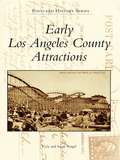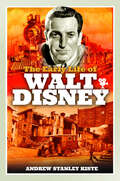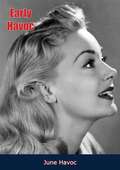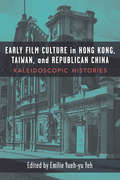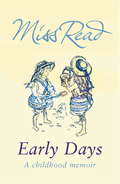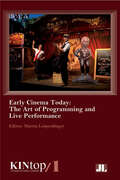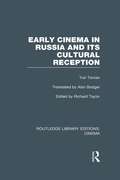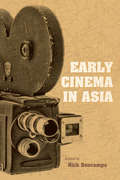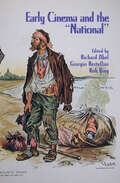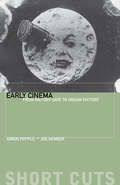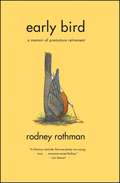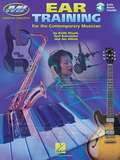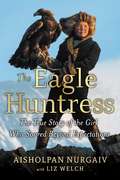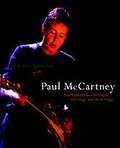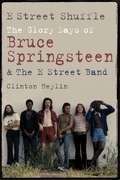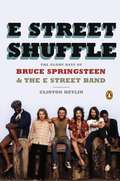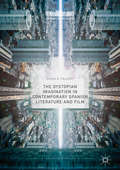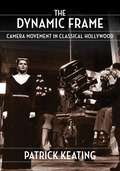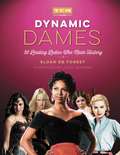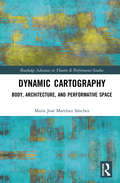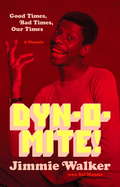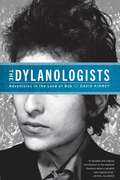- Table View
- List View
Early Los Angeles County Attractions
by Cory Stargel Sarah StargelWith the arrival of affordable transcontinental rail travel in the late 1880s, hundreds of thousands of tourists and transplants began making the trip to Los Angeles. Quickly becoming a haven for Easterners escaping cold winters and crowded cities, Los Angeles and neighboring communities, such as Pasadena and Santa Monica, boasted a sunny Mediterranean climate and the unique situation of both nearby mountain resorts and seaside amusements. The city also developed a bustling shopping and entertainment district downtown. More than 200 vintage postcard images illustrate a greatly diverse range of popular early attractions, including Mount Lowe, Eastlake Park, Hollywood, the Wilshire district, Griffith Park, Cawston's Ostrich Farm, the downtown shopping and theater district, and the expansive beaches, ranging from the turn of the 19th century up until World War II.
The Early Life of Walt Disney
by Andrew Stanley KisteThe Origins of Walt Disney tells the story of the famous artist and entertainer in a fresh way, placing him in the cultural narrative of twentieth century America and the world.Most biographies of Walt Disney portray him as a creative genius who revolutionized the entertainment industry during the first half of the twentieth century. While he did transform the medium of animation, quickly becoming a household name during his late thirties, many biographies tell the story of Walt Disney’s development in a historical vacuum, separate from the historical events happening around him. However, while Walt Disney was certainly a history-influencer, historical events happening in America and the world also shaped the entertainment pioneer he would become. As the twentieth century began, a new form of entertainment, “motion pictures,” would emerge, capturing the imagination of a young boy from Missouri. Over the next several years, Walt Disney would begin to hone his art skills, overcoming a number of hurdles including numerous relocations, a brutal paper route, a deployment to Europe in the days after World War One, numerous bankruptcies, and even homelessness. It was these adversities, along with the historical events that surrounded him, that would influence the man he would become. For the first time ever, The Early Life of Walt Disney tells some important stories that help to flesh out the Disney history. How instrumental was Elias Disney’s career as a carpenter in Chicago? Why did the Disneys really leave Chicago to move to Marceline, Missouri? What types of jobs did Walt perform in France in the days following World War One? How was Walt influenced by the budding industry of animation in America? In addition to answering these questions, The Origins of Walt Disney also includes a tour of the newly restored Walt Disney Birthplace, a new museum located in the childhood home of Walt Disney in Chicago, Illinois!
Early Havoc
by June HavocShe could dance on her toes when she was eighteen months old (and by heaven she had to!).June Havoc is the famous younger sister of Gypsy Rose Lee, and the daughter of Mrs. Rose Hovick, whose life story was fancifully portrayed by Ethel Merman in the 1959 smash-hit Broadway musical Gypsy.In Early Havoc, June tells quite another story, the inside story of a ruthless, conscienceless, ambition-driven woman who stripped her own daughters of their childhood. Early Havoc is a book that gets beneath the glitter of “show biz,”, and reveals the savage reality, as only the real autobiography of a trouper can.“A remarkable show-business document that might be titled ‘How to Make Good in Spite of Mother, Men and Marathons!’—TIME“Tensely dramatic…these are the years in which a child and a girl were beaten, pounded and shaped into womanhood.”—New York Herald Tribune
Early Film Culture in Hong Kong, Taiwan, and Republican China: Kaleidoscopic Histories
by Emilie Yueh-yu YehThis volume features new work on cinema in early twentieth-century Hong Kong, Taiwan, and Republican China. Looking beyond relatively well-studied cities like Shanghai, these essays foreground cinema’s relationship with imperialism and colonialism and emphasize the rapid development of cinema as a sociocultural institution. These essays examine where films were screened; how cinema-going as a social activity adapted from and integrated with existing social norms and practices; the extent to which Cantonese opera and other regional performance traditions were models for the development of cinematic conventions; the role foreign films played in the development of cinema as an industry in the Republican era; and much more.
Early Days
by Miss ReadThe enchanting childhood memoirs of bestselling author Miss Read.Miss Read's early days were spent with two remarkable grandmothers - one in Lewisham and one in Walton-on-the-Naze. EARLY DAYS is full of childhood memories of an extended family of uncles, aunts and cousins and their houses full of mystery and adventure, where Miss Read spent so much time, living in the shadow of the First World War.At the age of seven, Miss Read moved to the small village of Chelsfield, Kent, into a magical new world - and so began her love of the English countryside which was to have such a strong influence on her career as a writer. Her evocative descriptions of the village school, the joys of exploring the woods and lanes rich in wildlife and of childhood events, from toffee-making to the treat of a lift on the corn-chandler's cart, vividly convey this time as one of the happiest of her life.
Early Days
by Miss ReadThe enchanting childhood memoirs of bestselling author Miss Read.Miss Read's early days were spent with two remarkable grandmothers - one in Lewisham and one in Walton-on-the-Naze. EARLY DAYS is full of childhood memories of an extended family of uncles, aunts and cousins and their houses full of mystery and adventure, where Miss Read spent so much time, living in the shadow of the First World War.At the age of seven, Miss Read moved to the small village of Chelsfield, Kent, into a magical new world - and so began her love of the English countryside which was to have such a strong influence on her career as a writer. Her evocative descriptions of the village school, the joys of exploring the woods and lanes rich in wildlife and of childhood events, from toffee-making to the treat of a lift on the corn-chandler's cart, vividly convey this time as one of the happiest of her life.
Early Cinema Today, KINtop 1: The Art Of Programming And Live Performance (KINtop #1)
by Martin LoiperdingerInvented in the 1890s and premiered in Paris by the Lumière brothers, the cinematograph along with Louis Le Prince's single-lens camera projector are considered by film historians to be the precursors to modern-day motion picture devices. These early movies were often shown in town halls, on fairgrounds, and in theaters, requiring special showmanship skills to effectively work the equipment and entertain onlookers. Within the last decade, film archives and film festivals have unearthed this lost art and have featured outstanding examples of the culture of early cinema reconfigured for today's audiences.
Early Cinema in Russia and its Cultural Reception (Routledge Library Editions: Cinema)
by Yuri TsivianThis book examines the development of cinematic form and culture in Russia, from its late nineteenth-century beginnings as a fairground attraction to the early post-Revolutionary years. The author traces the changing perceptions of cinema and its social transition from a modernist invention to a national art form. He explores reactions to the earliest films from actors, novelists, poets, writers and journalists. His richly detailed study of the physical elements of cinematic performance includes the architecture and illumination of the cinema foyer, the speed of projection and film acoustics. In contrast to standard film histories, this book focuses on reflected images: rather than discussing films and film-makers, it features the historical film-goer and early writings on film. The book presents a vivid and changing picture of cinema culture in Russia in the twilight of the tsarist era and the first decades of the twentieth century. The study expands the whole context of reception studies and opens up questions about reception relevant to other national cinemas.
Early Cinema in Asia
by Nick DeocampoEarly Cinema in Asia explores how cinema became a popular medium in the world’s largest and most diverse continent. Beginning with the end of Asia’s colonial period in the 19th century, contributors to this volume document the struggle by pioneering figures to introduce the medium of film to the vast continent, overcoming geographic, technological, and cultural difficulties. As an early form of globalization, film’s arrival and phenomenal growth throughout various Asian countries penetrated not only colonial territories but also captivated collective states of imagination. With the coming of the 20th century, the medium that began as mere entertainment became a means for communicating many of the cultural identities of the region’s ethnic nationalities, as they turned their favorite pastime into an expression of their cherished national cultures. Covering diverse locations, including China, India, Japan, Philippines, Malaysia, Thailand, Iran, and the countries of the Pacific Islands, contributors to this volume reveal the story of early cinema in Asia, helping us to understand the first seeds of a medium that has since grown deep roots in the region.
Early Cinema and the "National"
by Richard Abel Rob King Giorgio BertelliniWhile many studies have been written on national cinemas, Early Cinema and the "National" is the first anthology to focus on the concept of national film culture from a wide methodological spectrum of interests, including not only visual and narrative forms, but also international geopolitics, exhibition and marketing practices, and pressing linkages to national imageries. The essays in this richly illustrated, landmark anthology are devoted to reconsidering the nation as a framing category for writing cinema history. Many of the 34 contributors show that concepts of a national identity played a role in establishing the parameters of cinema's early development, from technological change to discourses of stardom, from emerging genres to intertitling practices. Yet, as others attest, national meanings could often become knotty in other contexts, when concepts of nationhood were contested in relation to colonial/imperial histories and regional configurations. Early Cinema and the "National" takes stock of a formative moment in cinema history, tracing the beginnings of the process whereby nations learned to imagine themselves through moving images.
Early Cinema: From Factory Gate to Dream Factory (Short Cuts)
by Simon Popple Joe KemberThis book introduces the reader to the study of cinema as a series of aesthetic, technological, cultural, ideological and economic debates while exploring new and challenging approaches to the subject. It explores the period 1895 to 1914 when cinema established itself as the leading form of visual culture among rapidly expanding global media, emerging from a rich tradition of scientific, economic, entertainment and educational practices and quickly developing as a worldwide institution.
Early Bird
by Rodney RothmanEveryone says they would like to retire early, but Rodney Rothman actually did it -- forty years early. Burnt out, he decides at the age of twenty-eight to get an early start on his golden years. He travels to Boca Raton, Florida, where he moves in with an elderly piano teacher at Century Village, a retirement village that is home to thousands of senior citizens. Early Bird is an irreverent, hilarious, and ultimately warmhearted account of Rodney's journey deep into the heart of retirement. Rodney struggles for acceptance from the senior citizens he shares a swimming pool with, and battles with cranky octogenarians who want him off their turf. The day-to-day dealings begin to wear on him. Before long he observes, "I don't think Tuesdays with Morrie would have been quite so uplifting if that guy had to spend more than one day a week with Morrie." Rodney throws himself into the spirit of retirement, fashioning a busy schedule of suntanning, shuffleboard, and gambling cruises. As the months pass, his neighbors seem to forget that he is fifty years younger than they are. He finds himself the potential romantic interest of an aging femme fatale. He joins a senior softball club and is disturbed to learn that he is the worst player on the team. For excitement he rides along with a volunteer police officer on his patrols, hunting for crime. But even the criminals in his community seem to have retired. Early Bird is a funny, insightful, and moving look at what happens to us when we retire, viewed from a remarkably premature perspective. Any reader who plans on becoming an old person will enjoy joining Rodney on his strange journey, as he reconsiders his notions of romance, family, friendship, and ultimately, whether he's ever going back to work.
The Earl Takes a Bride
by Kathryn JensenFAIRY TALES DO COME TRUE.... Nonsense! Diane Fields, smart, practical, single mother of three, didn't believe in happily-ever- afters--even if her sister was married to the king of Elbia. But here was Earl Thomas Smythe, the rugged, debonair bodyguard to Diane's royal brother-in-law, standing in Diane's kitchen offering to whisk her away to Elbia's luxurious palace-and for a little rest and relaxation, no less! Why, Diane almost took the earl's suggestion as a joke--except there was no doubting the fiery ardor in the eyes of the kings emissary. And there was no doubting that Thomas was stirring up a very passionate response deep in Diane's soul....
Ear Training: The Complete Guide For All Musicians
by Wyatt Keith Joe Elliott Carl J. Schroeder Keith WyattThis book takes you step by step through MI's well-known Ear Training course. Complete lessons and analysis include: basic pitch matching * singing major and minor scales * identifying intervals * transcribing melodies and rhythm * identifying chords and progressions * seventh chords and the blues * modal interchange, chromaticism, modulation * and more! Learn to hear and to visualize on your instrument. Take your playing from good to great! Over 2 hours of practice exercises with complete answers in the back.
The Eagle Huntress: The True Story of the Girl Who Soared Beyond Expectations
by Aisholpan NurgaivThe subject of the award-winning documentary The Eagle Huntress tells the true story of how she became the first girl to compete in -- and win -- one of Mongolia's most prestigious competitions.In this compelling memoir, teenaged eagle hunter Aisholpan Nurgaiv tells her own story for the first time, speaking directly with award-winning and New York Times bestselling author Liz Welch (I Will Always Write Back), who traveled to Mongolia for this book. Nurgaiv's story and fresh, sincere voice are not only inspiring but truly magnificent: with the support of her father, she captured and trained her own golden eagle and won the Ölgii eagle festival. She was the only girl to compete in the festival.Filled with stunning photographs, The Eagle Huntress is a striking tale of determination -- of a girl who defied expectations and achieved what others declared impossible. Aisholpan Nurgaiv's story is both unique and universally relatable: a memoir of survival, empowerment, and the positive impact of one person's triumph.
Each One Believing: On Stage, Off Stage, and Backstage
by Paul MccartneyFans of McCartney will relish this volume of photos and interviews recording the singer's record-breaking 2002-2003 world tour. The text is taken from interviews and conversations filmed during the tour. Annotation ©2004 Book News, Inc., Portland, OR (booknews.com)
E Street Shuffle: The Glory Days of Bruce Springsteen and the E Street Band
by Clinton HeylinBruce Springsteen is one of the most important and controversial rock stars of our times: this is the story of the man - a complex, poetic loner whose albums went on to sell 18 million copies - and the band that gave his inner vision a punch and a swagger. Clinton Heylin has written the most factually accurate, informative book on Springsteen to date. As in Heylin's definitive Bob Dylan title Revolution in the Air, E Street Shuffle will focus on Bruce Springsteen and his work: the songs he's written, the way they were recorded, how they sounded live. Heylin also has unparalleled access to the people around Springsteen: current and former members of the E Street Band; CBS A&R personnel; Springsteen's 'New Dylan' contemporaries, as well as fellow Asbury Park musicians and scenesters, and rock critics. This is the essential book for any fan of the Boss.Praise for Clinton Heylin:"Arguably the world's greatest rock biographer." - The Irish Independent."The only Dylanologist worth reading." - The New York Times.
E Street Shuffle: The Glory Days of Bruce Springsteen & the E Street Band
by Clinton HeylinFrom Clinton Heylin, an intimate look at one of rock's brightest stars and his legendary backing band.
E Street Shuffle
by Clinton HeylinThe celebrated popular music scholar presents an intimate portrait of The Boss and his legendary band Bruce Springsteen fans know that the band makes the man, which is why millions of people have jammed stadiums and arenas to see The Boss play countless shows with his incredible E Street Band. In this revelatory and unapologetic biography, respected music scholar Clinton Heylin turns a critical eye towards Springsteen's early days, capturing this classic phase of his career and his rise from Asbury Park hood rat to global rock star. Using long-buried archival recordings and bootlegs, Heylin expertly traces Springsteen's creative process as a songwriter and performer and illuminates the roles of the E Street Band members in creating their distinctive sound. Highly nuanced and as fiery as Springsteen himself, E Street Shuffle offers the most revealing portrait yet written on this American icon.
The Dystopian Imagination in Contemporary Spanish Literature and Film (Hispanic Urban Studies)
by Diana Q. PalardyThis study examines contemporary Spanish dystopian literature and films (in)directly related to the 2008 financial crisis from an urban cultural studies perspective. It explores culturally-charged landscapes that effectively convey the zeitgeist and reveal deep-rooted anxieties about issues such as globalization, consumerism, immigration, speculation, precarity, and political resistance (particularly by Indignados [Indignant Ones] from the 15-M Movement). The book loosely traces the trajectory of the crisis, with the first part looking at texts that underscore some of the behaviors that indirectly contributed to the crisis, and the remaining chapters focusing on works that directly examine the crisis and its aftermath. This close reading of texts and films by Ray Loriga, Elia Barceló, Ion de Sosa, José Ardillo, David Llorente, Eduardo Vaquerizo, and Ricardo Menéndez Salmón offers insights into the creative ways that these authors and directors use spatial constructions to capture the dystopian imagination.
The Dynamic Frame: Camera Movement in Classical Hollywood (Film and Culture Series)
by Patrick KeatingThe camera’s movement in a film may seem straightforward or merely technical. Yet skillfully deployed pans, tilts, dollies, cranes, and zooms can express the emotions of a character, convey attitude and irony, or even challenge an ideological stance. In The Dynamic Frame, Patrick Keating offers an innovative history of the aesthetics of the camera that examines how camera movement shaped the classical Hollywood style.In careful readings of dozens of films, including Sunrise, The Grapes of Wrath, Rear Window, Sunset Boulevard, and Touch of Evil, Keating explores how major figures such as F. W. Murnau, Orson Welles, and Alfred Hitchcock used camera movement to enrich their stories and deepen their themes. Balancing close analysis with a broader poetics of camera movement, Keating uses archival research to chronicle the technological breakthroughs and the changing division of labor that allowed for new possibilities, as well as the shifting political and cultural contexts that inspired filmmakers to use technology in new ways. An original history of film techniques and aesthetics, The Dynamic Frame shows that the classical Hollywood camera moves not to imitate the actions of an omniscient observer but rather to produce the interplay of concealment and revelation that is an essential part of the exchange between film and viewer.
Dynamic Dames: 50 Leading Ladies Who Made History (Turner Classic Movies)
by Sloan De ForestCelebrate 50 of the most empowering and unforgettable female characters ever to grace the screen, as well as the artists who brought them to vibrant life!From Scarlett O'Hara to Thelma and Louise to Wonder Woman, strong women have not only lit up the screen, they've inspired and fired our imaginations. Some dynamic women are naughty and some are nice, but all of them buck the narrow confines of their expected gender role -- whether by taking small steps or revolutionary strides.Through engaging profiles and more than 100 photographs, Dynamic Dames looks at fifty of the most inspiring female roles in film from the 1920s to today. The characters are discussed along with the exciting off-screen personalities and achievements of the actresses and, on occasion, female writers and directors, who brought them to life.Among the stars profiled in their most revolutionary roles are Bette Davis, Mae West, Barbara Stanwyck, Josephine Baker, Greta Garbo, Audrey Hepburn, Natalie Wood, Barbra Streisand, Julia Roberts, Meryl Streep, Joan Crawford, Vivien Leigh, Elizabeth Taylor, Dorothy Dandridge, Katharine Hepburn, Pam Grier, Jane Fonda, Gal Gadot, Emma Watson, Zhang Ziyi, Uma Thurman, Jennifer Lawrence, and many more.
Dynamic Cartography: Body, Architecture, and Performative Space (Routledge Advances in Theatre & Performance Studies)
by María José Martínez SánchezDynamic Cartography analyses the works of Rudolf Laban, Lawrence Halprin, Anne Bogart, Adolphe Appia, Cedric Price, Joan Littlewood, and Hélio Oiticica. They are practitioners who have worked on different areas of enquiry from the existing relations between body and space through movement, events, or actions but whose work has never been presented from this perspective or in this context. The work and methodologies set up by these practitioners enable us to develop a practice-based exploration. Some of the experiments in the book – Micro-actions I and II – explore the presence of the body in the space. In Kinetography I and II, Laban’s dance notation system – kinetography – is used to create these dynamic cartographies. Kinetography III proposes the analysis of an urban public space through the transcription of the body movement contained on it. The series Dynamic Cartographies I, II, and III analyses movement in geometrically controlled spaces through the Viewpoints techniques by Anne Bogart. Finally, Wooosh! and Trellick Tales present two projects in which performance is applied in order to analyse and understand urban and architectural space.
Dyn-o-mite!: Good Times, Bad Times, Our Times -- A Memoir
by Jimmie Walker Sal MannaJimmie Walker was born in 1947 in the Bronx. At 22, he began performing as a standup comedian and was eventually discovered by the casting director for "Good Times." Walker was the first successful young black sitcom star, and his catchphrase--"Dyn-o-mite!"--remains an indicator of the era. He continues to tour the country doing stand-up and lives in Las Vegas.
The Dylanologists
by David KinneyFAN: "You don't know who I am, but I know who you are."BOB DYLAN: "Let's keep it that way."Bob Dylan is the most influential songwriter of our time and, after a half century, he remains a cultural touchstone, an enigma, and the subject of endless fascination. From the moment he arrived on the music scene, he attracted an intensely fanatical cult following, and in The Dylanologists, Pulitzer Prize-winning journalist David Kinney ventures deep into this eccentric subculture to answer a question: What can Dylan's grip on his most enthusiastic listeners tell us about his towering place in American culture?Kinney introduces us to a vibrant underground: diggers searching for unheard tapes and lost manuscripts, researchers obsessing over the facts of Dylan's life and career, writers working to decode unyieldingly mysterious songs, road warriors who meticulously record and dissect every concert. It's an affectionate mania, but as far as Dylan is concerned, a mania nonetheless. Over the years, the intensely private and fiercely combative musician has been frightened, annoyed, and perplexed by fans who try to peel back his layers. He has made at least one thing crystal clear: He does not wish to be known.The story of Dylan's followers is also a revealing portrait of the artist himself. Here, reflected in the fans he inspired and the cultural movements he helped create, is every twist and turn in a career that has swerved from lefty activist to ultra-hip spokesman for a generation to woodsy recluse, from secular storyteller to fire-breathing Christian evangelist, from punch line to elder statesman. Dylan may refuse to explain himself to his followers, but their lives have become mirrors of his, so profoundly are their stories intertwined.Told with tremendous insight, intelligence, and warmth, by turns funny and affecting, The Dylanologists is ultimately a book about our universal quest for meaning. It is populated by characters both legendary and obscure, from aging hippies to idealistic twentysomethings and everyone in between--a young woman who, stirred by Dylan, attends law school and becomes a public defender; a man who crams his New York City apartment with memorabilia, transforming it into a pilgrimage spot for Dylan fanatics; a woman inspired by her hero's redemptive music to go clean after years of drug use. Here is a joyous, soulful, and poignant exploration of the origins and meaning of fandom, the healing power of art, and the importance of embracing what moves you, whatever that may be.
